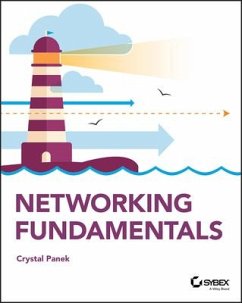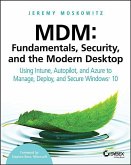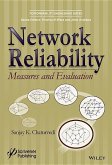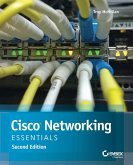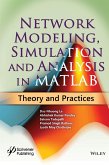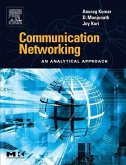Crystal Panek
Networking Fundamentals
Andere Kunden interessierten sich auch für
![MDM: Fundamentals, Security, and the Modern Desktop MDM: Fundamentals, Security, and the Modern Desktop]() Jeremy MoskowitzMDM: Fundamentals, Security, and the Modern Desktop44,99 €
Jeremy MoskowitzMDM: Fundamentals, Security, and the Modern Desktop44,99 €![Group Policy Group Policy]() Jeremy MoskowitzGroup Policy52,99 €
Jeremy MoskowitzGroup Policy52,99 €![Network Reliability Network Reliability]() Sanjay Kumar ChaturvediNetwork Reliability232,99 €
Sanjay Kumar ChaturvediNetwork Reliability232,99 €![Edge Networking Edge Networking]() Khaldoun Al AghaEdge Networking180,99 €
Khaldoun Al AghaEdge Networking180,99 €![Cisco Networking Essentials Cisco Networking Essentials]() Troy McmillanCisco Networking Essentials36,99 €
Troy McmillanCisco Networking Essentials36,99 €![Network Modeling, Simulation and Analysis in MATLAB Network Modeling, Simulation and Analysis in MATLAB]() Dac-Nhuong LeNetwork Modeling, Simulation and Analysis in MATLAB258,99 €
Dac-Nhuong LeNetwork Modeling, Simulation and Analysis in MATLAB258,99 €![Communication Networking Communication Networking]() Anurag KumarCommunication Networking134,99 €
Anurag KumarCommunication Networking134,99 €-
-
-
Produktdetails
- Verlag: Wiley
- Seitenzahl: 336
- Erscheinungstermin: 12. November 2019
- Englisch
- Abmessung: 234mm x 188mm x 18mm
- Gewicht: 454g
- ISBN-13: 9781119650744
- ISBN-10: 1119650747
- Artikelnr.: 58016829
Hinweis: Dieser Artikel kann nur an eine deutsche Lieferadresse ausgeliefert werden.
- Herstellerkennzeichnung
- Libri GmbH
- Europaallee 1
- 36244 Bad Hersfeld
- gpsr@libri.de
ABOUT THE AUTHOR Crystal Panek, MCP, MCP+I, MCSA, MCSE, MCTS, MCDBA currently works on a contract basis creating courseware for several large IT training facilities. For over 15 years, she served as vice-president of a large IT training company where she developed training materials and courseware to help 1000's of students get through their certification exams. She has trained students and IT professionals at the MicroC, Stellacon Corporation, and the University of New Hampshire.
Introduction xv
Lesson 1 Understanding Local Area Networking 1
Examining Local Area Networks, Devices, and Data Transfer 3
Defining the LAN 3
Identifying Types of LANs 20
Getting to Know Perimeter Networks 23
Identifying Network Topologies and Standards 25
Identifying Network Topologies 25
Defining Ethernet Standards 29
Identifying the Differences Between Client/Server and Peer-to-Peer 32
Skill Summary 36
Knowledge Assessment 38
Multiple Choice 38
Fill in the Blank 40
Business Case Scenarios 41
Scenario 1-1: Planning and Documenting a Basic LAN 41
Scenario 1-2: Selecting the Correct Networking Model 41
Scenario 1-3: Selecting Network Adapters for Your LAN Computers 41
Scenario 1-4: Configuring the Correct Subnet Mask 41
Solutions to Business Case Scenarios 42
Lesson 2 Defining Networks with the OSI Model 43
Understanding OSI Basics 45
Defining the OSI Model Layers 46
Defining the Communications Subnetwork 48
Define the Physical Layer 49
Define the Data Link Layer 51
Understanding Layer 2 Switching 52
Understanding Layer 3 Switching 56
Understanding Characteristics of Switches 56
Defining the Upper OSI Layers 58
Defining the Transport Layer 59
Defining the Session Layer 62
Defining the Presentation Layer 63
Defining the Application Layer 64
Reviewing the OSI Layers 65
Defining the TCP/IP Model 67
Skill Summary 68
Knowledge Assessment 69
Multiple Choice 69
Fill in the Blank 71
Business Case Scenarios 71
Scenario 2-1: Installing the Appropriate Switch 71
Scenario 2-2: Defining the IP Address and Ports Used by Destination Servers
72
Scenario 2-3: Ensuring a Newly Created Email Account's Logon is Encrypted
72
Scenario 2-4: Creating a Permanent ARP Table Entry 72
Lesson 3 Understanding Wired and Wireless Networks 75
Recognizing Wired Networks and Media Types 77
Identifying and Working with Twisted-Pair Cables 77
Identifying and Working with Fiber-Optic Cable 86
Understanding Wireless Networks 89
Identifying Wireless Devices 89
Identifying Wireless Networking Standards 91
Skill Summary 97
Knowledge Assessment 98
Multiple Choice 98
Fill in the Blank 100
Business Case Scenarios 100
Scenario 3-1: Selecting Channels for a WLAN 100
Scenario 3-2: Running Cable Drops Properly 100
Scenario 3-3: Selecting Network Adapters for Your WLAN Computers 101
Scenario 3-4: Securing a WLAN 101
Lesson 4 Understanding Internet Protocol 103
Working with IPV4 105
Categorizing IPv4 Addresses 105
Default Gateways and DNS Servers 114
Defining Advanced IPv4 Concepts 117
Working with IPV6 129
Understanding IPv6 130
Configuring IPv6 133
Skill Summary 140
Knowledge Assessment 142
Multiple Choice 142
Fill in the Blank 144
Business Case Scenarios 145
Scenario 4-1: Defining a Private Class C IP Network 145
Scenario 4-2: Specifying the Correct Device 145
Scenario 4-3: Implementing the Correct Class Network 145
Scenario 4-4: Implementing the Correct Subnet Mask 145
Lesson 5 Implementing TCP/IP in the Command Line 147
Using Basic TCP/IP Commands 149
Working with the Command Prompt Window 149
Using ipconfig and ping 152
Working with Advanced TCP/IP Commands 162
Using netstat and nbtstat 162
Using tracert and pathping 167
Using nslookup 170
Using ftp and telnet 171
Using Windows PowerShell 173
Using net 180
Skill Summary 188
Knowledge Assessment 189
Multiple Choice 189
Fill in the Blank 192
Business Case Scenarios 195
Scenario 5-1: Connecting to an FTP Server 195
Scenario 5-2: Troubleshooting TCP/IP Results 195
Scenario 5-3: Documenting a Basic Wide Area Network 196
Scenario 5-4: Using Advanced Ping 196
Lesson 6 Working with Networking Services 199
Setting Up Common Networking Services 201
Working with the Dynamic Host Configuration Protocol (DHCP) 202
Introducing Remote Administration 208
Enable Remote Desktop 210
Access Remote Desktop 210
Defining More Networking Services 213
Defining RRAS 213
Defining IPsec 217
Defining Name Resolution Techniques 218
Defining DNS 218
Defining WINS 222
Skill Summary 223
Knowledge Assessment 225
Multiple Choice 225
Fill in the Blank 227
Business Case Scenarios 227
Scenario 6-1: Selecting the Appropriate Services 227
Scenario 6-2: Selecting the Appropriate Services 228
Scenario 6-3: Setting Up a DHCP Server 228
Scenario 6-4: Setting Up a New DHCP and Migrating Old Computers 228
Scenario 6-5: Managing Remote Connections 228
Lesson 7 Understanding Wide Area Networks 231
Understanding Routing 233
Identifying Static and Dynamic Routing 233
Understanding Quality of Service (QOS) 237
Defining Common WAN Technologies and Connections 239
Defining Packet Switching 239
Defining T-Carriers 249
Defining Other WAN Technologies and Internet Connectivity 250
Skill Summary 252
Knowledge Assessment 254
Multiple Choice 254
Fill in the Blank 256
Business Case Scenarios 256
Scenario 7-1: Selecting the Appropriate Service and Protocol 256
Scenario 7-2: Selecting the Appropriate WAN Technology 256
Scenario 7-3: Recommending the Right Service 257
Scenario 7-4: Setting Up Routes to Other Networks 257
Lesson 8 Defining Network Infrastructures and Network Security 259
Understanding Networks Outside the LAN 261
Defining the Internet 261
Defining Intranets and Extranets 262
Configuring VPN Connections and Authentication 264
Selecting Types of VPN Protocols 265
Selecting Authentication for VPN Connections 267
Creating a VPN Connection Using the Create a VPN Connection Wizard 268
Creating a VPN Connection Using Windows 10 Settings 270
Using Connection Manager (CM) and the Connection Manager Administration Kit
(CMAK) 272
Understanding Security Devices and Zones 273
Defining Firewalls and Other Perimeter Security Devices 273
Redefining the DMZ 277
Putting It All Together 278
Skill Summary 281
Knowledge Assessment 282
Multiple Choice 282
Fill in the Blank 284
Business Case Scenarios 285
Scenario 8-1: Setting Up a DMZ 285
Scenario 8-2: Selecting the Appropriate Solution 285
Scenario 8-3: Setting Up a PPTP Server 285
Scenario 8-4: Creating a WAN with VPN 286
Appendix Answer Key 289
Lesson 1: Understanding Local Area Networking 290
Answers to Knowledge Assessment 290
Answers to Business Case Scenarios 291
Lesson 2: Defining Networks with the OSI Model 292
Answers to Knowledge Assessment 292
Answers to Business Case Scenarios 293
Lesson 3: Understanding Wired and Wireless Networks 293
Answers to Knowledge Assessment 293
Answers to Business Case Scenarios 294
Lesson 4: Understanding Internet Protocol 295
Answers to Knowledge Assessment 295
Answers to Business Case Scenarios 296
Lesson 5: Implementing TCP/IP in the Command Line 297
Answers to Knowledge Assessment 297
Answers to Business Case Scenarios 298
Lesson 6: Working with Networking Services 298
Answers to Knowledge Assessment 298
Answers to Business Case Scenarios 299
Lesson 7: Understanding Wide Area Networks 301
Answers to Knowledge Assessment 301
Answers to Business Case Scenarios 302
Lesson 8: Defining Network Infrastructure and Network Security 302
Answers to Knowledge Assessment 302
Answers to Business Case Scenarios 303
Index 305
Lesson 1 Understanding Local Area Networking 1
Examining Local Area Networks, Devices, and Data Transfer 3
Defining the LAN 3
Identifying Types of LANs 20
Getting to Know Perimeter Networks 23
Identifying Network Topologies and Standards 25
Identifying Network Topologies 25
Defining Ethernet Standards 29
Identifying the Differences Between Client/Server and Peer-to-Peer 32
Skill Summary 36
Knowledge Assessment 38
Multiple Choice 38
Fill in the Blank 40
Business Case Scenarios 41
Scenario 1-1: Planning and Documenting a Basic LAN 41
Scenario 1-2: Selecting the Correct Networking Model 41
Scenario 1-3: Selecting Network Adapters for Your LAN Computers 41
Scenario 1-4: Configuring the Correct Subnet Mask 41
Solutions to Business Case Scenarios 42
Lesson 2 Defining Networks with the OSI Model 43
Understanding OSI Basics 45
Defining the OSI Model Layers 46
Defining the Communications Subnetwork 48
Define the Physical Layer 49
Define the Data Link Layer 51
Understanding Layer 2 Switching 52
Understanding Layer 3 Switching 56
Understanding Characteristics of Switches 56
Defining the Upper OSI Layers 58
Defining the Transport Layer 59
Defining the Session Layer 62
Defining the Presentation Layer 63
Defining the Application Layer 64
Reviewing the OSI Layers 65
Defining the TCP/IP Model 67
Skill Summary 68
Knowledge Assessment 69
Multiple Choice 69
Fill in the Blank 71
Business Case Scenarios 71
Scenario 2-1: Installing the Appropriate Switch 71
Scenario 2-2: Defining the IP Address and Ports Used by Destination Servers
72
Scenario 2-3: Ensuring a Newly Created Email Account's Logon is Encrypted
72
Scenario 2-4: Creating a Permanent ARP Table Entry 72
Lesson 3 Understanding Wired and Wireless Networks 75
Recognizing Wired Networks and Media Types 77
Identifying and Working with Twisted-Pair Cables 77
Identifying and Working with Fiber-Optic Cable 86
Understanding Wireless Networks 89
Identifying Wireless Devices 89
Identifying Wireless Networking Standards 91
Skill Summary 97
Knowledge Assessment 98
Multiple Choice 98
Fill in the Blank 100
Business Case Scenarios 100
Scenario 3-1: Selecting Channels for a WLAN 100
Scenario 3-2: Running Cable Drops Properly 100
Scenario 3-3: Selecting Network Adapters for Your WLAN Computers 101
Scenario 3-4: Securing a WLAN 101
Lesson 4 Understanding Internet Protocol 103
Working with IPV4 105
Categorizing IPv4 Addresses 105
Default Gateways and DNS Servers 114
Defining Advanced IPv4 Concepts 117
Working with IPV6 129
Understanding IPv6 130
Configuring IPv6 133
Skill Summary 140
Knowledge Assessment 142
Multiple Choice 142
Fill in the Blank 144
Business Case Scenarios 145
Scenario 4-1: Defining a Private Class C IP Network 145
Scenario 4-2: Specifying the Correct Device 145
Scenario 4-3: Implementing the Correct Class Network 145
Scenario 4-4: Implementing the Correct Subnet Mask 145
Lesson 5 Implementing TCP/IP in the Command Line 147
Using Basic TCP/IP Commands 149
Working with the Command Prompt Window 149
Using ipconfig and ping 152
Working with Advanced TCP/IP Commands 162
Using netstat and nbtstat 162
Using tracert and pathping 167
Using nslookup 170
Using ftp and telnet 171
Using Windows PowerShell 173
Using net 180
Skill Summary 188
Knowledge Assessment 189
Multiple Choice 189
Fill in the Blank 192
Business Case Scenarios 195
Scenario 5-1: Connecting to an FTP Server 195
Scenario 5-2: Troubleshooting TCP/IP Results 195
Scenario 5-3: Documenting a Basic Wide Area Network 196
Scenario 5-4: Using Advanced Ping 196
Lesson 6 Working with Networking Services 199
Setting Up Common Networking Services 201
Working with the Dynamic Host Configuration Protocol (DHCP) 202
Introducing Remote Administration 208
Enable Remote Desktop 210
Access Remote Desktop 210
Defining More Networking Services 213
Defining RRAS 213
Defining IPsec 217
Defining Name Resolution Techniques 218
Defining DNS 218
Defining WINS 222
Skill Summary 223
Knowledge Assessment 225
Multiple Choice 225
Fill in the Blank 227
Business Case Scenarios 227
Scenario 6-1: Selecting the Appropriate Services 227
Scenario 6-2: Selecting the Appropriate Services 228
Scenario 6-3: Setting Up a DHCP Server 228
Scenario 6-4: Setting Up a New DHCP and Migrating Old Computers 228
Scenario 6-5: Managing Remote Connections 228
Lesson 7 Understanding Wide Area Networks 231
Understanding Routing 233
Identifying Static and Dynamic Routing 233
Understanding Quality of Service (QOS) 237
Defining Common WAN Technologies and Connections 239
Defining Packet Switching 239
Defining T-Carriers 249
Defining Other WAN Technologies and Internet Connectivity 250
Skill Summary 252
Knowledge Assessment 254
Multiple Choice 254
Fill in the Blank 256
Business Case Scenarios 256
Scenario 7-1: Selecting the Appropriate Service and Protocol 256
Scenario 7-2: Selecting the Appropriate WAN Technology 256
Scenario 7-3: Recommending the Right Service 257
Scenario 7-4: Setting Up Routes to Other Networks 257
Lesson 8 Defining Network Infrastructures and Network Security 259
Understanding Networks Outside the LAN 261
Defining the Internet 261
Defining Intranets and Extranets 262
Configuring VPN Connections and Authentication 264
Selecting Types of VPN Protocols 265
Selecting Authentication for VPN Connections 267
Creating a VPN Connection Using the Create a VPN Connection Wizard 268
Creating a VPN Connection Using Windows 10 Settings 270
Using Connection Manager (CM) and the Connection Manager Administration Kit
(CMAK) 272
Understanding Security Devices and Zones 273
Defining Firewalls and Other Perimeter Security Devices 273
Redefining the DMZ 277
Putting It All Together 278
Skill Summary 281
Knowledge Assessment 282
Multiple Choice 282
Fill in the Blank 284
Business Case Scenarios 285
Scenario 8-1: Setting Up a DMZ 285
Scenario 8-2: Selecting the Appropriate Solution 285
Scenario 8-3: Setting Up a PPTP Server 285
Scenario 8-4: Creating a WAN with VPN 286
Appendix Answer Key 289
Lesson 1: Understanding Local Area Networking 290
Answers to Knowledge Assessment 290
Answers to Business Case Scenarios 291
Lesson 2: Defining Networks with the OSI Model 292
Answers to Knowledge Assessment 292
Answers to Business Case Scenarios 293
Lesson 3: Understanding Wired and Wireless Networks 293
Answers to Knowledge Assessment 293
Answers to Business Case Scenarios 294
Lesson 4: Understanding Internet Protocol 295
Answers to Knowledge Assessment 295
Answers to Business Case Scenarios 296
Lesson 5: Implementing TCP/IP in the Command Line 297
Answers to Knowledge Assessment 297
Answers to Business Case Scenarios 298
Lesson 6: Working with Networking Services 298
Answers to Knowledge Assessment 298
Answers to Business Case Scenarios 299
Lesson 7: Understanding Wide Area Networks 301
Answers to Knowledge Assessment 301
Answers to Business Case Scenarios 302
Lesson 8: Defining Network Infrastructure and Network Security 302
Answers to Knowledge Assessment 302
Answers to Business Case Scenarios 303
Index 305
Introduction xv
Lesson 1 Understanding Local Area Networking 1
Examining Local Area Networks, Devices, and Data Transfer 3
Defining the LAN 3
Identifying Types of LANs 20
Getting to Know Perimeter Networks 23
Identifying Network Topologies and Standards 25
Identifying Network Topologies 25
Defining Ethernet Standards 29
Identifying the Differences Between Client/Server and Peer-to-Peer 32
Skill Summary 36
Knowledge Assessment 38
Multiple Choice 38
Fill in the Blank 40
Business Case Scenarios 41
Scenario 1-1: Planning and Documenting a Basic LAN 41
Scenario 1-2: Selecting the Correct Networking Model 41
Scenario 1-3: Selecting Network Adapters for Your LAN Computers 41
Scenario 1-4: Configuring the Correct Subnet Mask 41
Solutions to Business Case Scenarios 42
Lesson 2 Defining Networks with the OSI Model 43
Understanding OSI Basics 45
Defining the OSI Model Layers 46
Defining the Communications Subnetwork 48
Define the Physical Layer 49
Define the Data Link Layer 51
Understanding Layer 2 Switching 52
Understanding Layer 3 Switching 56
Understanding Characteristics of Switches 56
Defining the Upper OSI Layers 58
Defining the Transport Layer 59
Defining the Session Layer 62
Defining the Presentation Layer 63
Defining the Application Layer 64
Reviewing the OSI Layers 65
Defining the TCP/IP Model 67
Skill Summary 68
Knowledge Assessment 69
Multiple Choice 69
Fill in the Blank 71
Business Case Scenarios 71
Scenario 2-1: Installing the Appropriate Switch 71
Scenario 2-2: Defining the IP Address and Ports Used by Destination Servers
72
Scenario 2-3: Ensuring a Newly Created Email Account's Logon is Encrypted
72
Scenario 2-4: Creating a Permanent ARP Table Entry 72
Lesson 3 Understanding Wired and Wireless Networks 75
Recognizing Wired Networks and Media Types 77
Identifying and Working with Twisted-Pair Cables 77
Identifying and Working with Fiber-Optic Cable 86
Understanding Wireless Networks 89
Identifying Wireless Devices 89
Identifying Wireless Networking Standards 91
Skill Summary 97
Knowledge Assessment 98
Multiple Choice 98
Fill in the Blank 100
Business Case Scenarios 100
Scenario 3-1: Selecting Channels for a WLAN 100
Scenario 3-2: Running Cable Drops Properly 100
Scenario 3-3: Selecting Network Adapters for Your WLAN Computers 101
Scenario 3-4: Securing a WLAN 101
Lesson 4 Understanding Internet Protocol 103
Working with IPV4 105
Categorizing IPv4 Addresses 105
Default Gateways and DNS Servers 114
Defining Advanced IPv4 Concepts 117
Working with IPV6 129
Understanding IPv6 130
Configuring IPv6 133
Skill Summary 140
Knowledge Assessment 142
Multiple Choice 142
Fill in the Blank 144
Business Case Scenarios 145
Scenario 4-1: Defining a Private Class C IP Network 145
Scenario 4-2: Specifying the Correct Device 145
Scenario 4-3: Implementing the Correct Class Network 145
Scenario 4-4: Implementing the Correct Subnet Mask 145
Lesson 5 Implementing TCP/IP in the Command Line 147
Using Basic TCP/IP Commands 149
Working with the Command Prompt Window 149
Using ipconfig and ping 152
Working with Advanced TCP/IP Commands 162
Using netstat and nbtstat 162
Using tracert and pathping 167
Using nslookup 170
Using ftp and telnet 171
Using Windows PowerShell 173
Using net 180
Skill Summary 188
Knowledge Assessment 189
Multiple Choice 189
Fill in the Blank 192
Business Case Scenarios 195
Scenario 5-1: Connecting to an FTP Server 195
Scenario 5-2: Troubleshooting TCP/IP Results 195
Scenario 5-3: Documenting a Basic Wide Area Network 196
Scenario 5-4: Using Advanced Ping 196
Lesson 6 Working with Networking Services 199
Setting Up Common Networking Services 201
Working with the Dynamic Host Configuration Protocol (DHCP) 202
Introducing Remote Administration 208
Enable Remote Desktop 210
Access Remote Desktop 210
Defining More Networking Services 213
Defining RRAS 213
Defining IPsec 217
Defining Name Resolution Techniques 218
Defining DNS 218
Defining WINS 222
Skill Summary 223
Knowledge Assessment 225
Multiple Choice 225
Fill in the Blank 227
Business Case Scenarios 227
Scenario 6-1: Selecting the Appropriate Services 227
Scenario 6-2: Selecting the Appropriate Services 228
Scenario 6-3: Setting Up a DHCP Server 228
Scenario 6-4: Setting Up a New DHCP and Migrating Old Computers 228
Scenario 6-5: Managing Remote Connections 228
Lesson 7 Understanding Wide Area Networks 231
Understanding Routing 233
Identifying Static and Dynamic Routing 233
Understanding Quality of Service (QOS) 237
Defining Common WAN Technologies and Connections 239
Defining Packet Switching 239
Defining T-Carriers 249
Defining Other WAN Technologies and Internet Connectivity 250
Skill Summary 252
Knowledge Assessment 254
Multiple Choice 254
Fill in the Blank 256
Business Case Scenarios 256
Scenario 7-1: Selecting the Appropriate Service and Protocol 256
Scenario 7-2: Selecting the Appropriate WAN Technology 256
Scenario 7-3: Recommending the Right Service 257
Scenario 7-4: Setting Up Routes to Other Networks 257
Lesson 8 Defining Network Infrastructures and Network Security 259
Understanding Networks Outside the LAN 261
Defining the Internet 261
Defining Intranets and Extranets 262
Configuring VPN Connections and Authentication 264
Selecting Types of VPN Protocols 265
Selecting Authentication for VPN Connections 267
Creating a VPN Connection Using the Create a VPN Connection Wizard 268
Creating a VPN Connection Using Windows 10 Settings 270
Using Connection Manager (CM) and the Connection Manager Administration Kit
(CMAK) 272
Understanding Security Devices and Zones 273
Defining Firewalls and Other Perimeter Security Devices 273
Redefining the DMZ 277
Putting It All Together 278
Skill Summary 281
Knowledge Assessment 282
Multiple Choice 282
Fill in the Blank 284
Business Case Scenarios 285
Scenario 8-1: Setting Up a DMZ 285
Scenario 8-2: Selecting the Appropriate Solution 285
Scenario 8-3: Setting Up a PPTP Server 285
Scenario 8-4: Creating a WAN with VPN 286
Appendix Answer Key 289
Lesson 1: Understanding Local Area Networking 290
Answers to Knowledge Assessment 290
Answers to Business Case Scenarios 291
Lesson 2: Defining Networks with the OSI Model 292
Answers to Knowledge Assessment 292
Answers to Business Case Scenarios 293
Lesson 3: Understanding Wired and Wireless Networks 293
Answers to Knowledge Assessment 293
Answers to Business Case Scenarios 294
Lesson 4: Understanding Internet Protocol 295
Answers to Knowledge Assessment 295
Answers to Business Case Scenarios 296
Lesson 5: Implementing TCP/IP in the Command Line 297
Answers to Knowledge Assessment 297
Answers to Business Case Scenarios 298
Lesson 6: Working with Networking Services 298
Answers to Knowledge Assessment 298
Answers to Business Case Scenarios 299
Lesson 7: Understanding Wide Area Networks 301
Answers to Knowledge Assessment 301
Answers to Business Case Scenarios 302
Lesson 8: Defining Network Infrastructure and Network Security 302
Answers to Knowledge Assessment 302
Answers to Business Case Scenarios 303
Index 305
Lesson 1 Understanding Local Area Networking 1
Examining Local Area Networks, Devices, and Data Transfer 3
Defining the LAN 3
Identifying Types of LANs 20
Getting to Know Perimeter Networks 23
Identifying Network Topologies and Standards 25
Identifying Network Topologies 25
Defining Ethernet Standards 29
Identifying the Differences Between Client/Server and Peer-to-Peer 32
Skill Summary 36
Knowledge Assessment 38
Multiple Choice 38
Fill in the Blank 40
Business Case Scenarios 41
Scenario 1-1: Planning and Documenting a Basic LAN 41
Scenario 1-2: Selecting the Correct Networking Model 41
Scenario 1-3: Selecting Network Adapters for Your LAN Computers 41
Scenario 1-4: Configuring the Correct Subnet Mask 41
Solutions to Business Case Scenarios 42
Lesson 2 Defining Networks with the OSI Model 43
Understanding OSI Basics 45
Defining the OSI Model Layers 46
Defining the Communications Subnetwork 48
Define the Physical Layer 49
Define the Data Link Layer 51
Understanding Layer 2 Switching 52
Understanding Layer 3 Switching 56
Understanding Characteristics of Switches 56
Defining the Upper OSI Layers 58
Defining the Transport Layer 59
Defining the Session Layer 62
Defining the Presentation Layer 63
Defining the Application Layer 64
Reviewing the OSI Layers 65
Defining the TCP/IP Model 67
Skill Summary 68
Knowledge Assessment 69
Multiple Choice 69
Fill in the Blank 71
Business Case Scenarios 71
Scenario 2-1: Installing the Appropriate Switch 71
Scenario 2-2: Defining the IP Address and Ports Used by Destination Servers
72
Scenario 2-3: Ensuring a Newly Created Email Account's Logon is Encrypted
72
Scenario 2-4: Creating a Permanent ARP Table Entry 72
Lesson 3 Understanding Wired and Wireless Networks 75
Recognizing Wired Networks and Media Types 77
Identifying and Working with Twisted-Pair Cables 77
Identifying and Working with Fiber-Optic Cable 86
Understanding Wireless Networks 89
Identifying Wireless Devices 89
Identifying Wireless Networking Standards 91
Skill Summary 97
Knowledge Assessment 98
Multiple Choice 98
Fill in the Blank 100
Business Case Scenarios 100
Scenario 3-1: Selecting Channels for a WLAN 100
Scenario 3-2: Running Cable Drops Properly 100
Scenario 3-3: Selecting Network Adapters for Your WLAN Computers 101
Scenario 3-4: Securing a WLAN 101
Lesson 4 Understanding Internet Protocol 103
Working with IPV4 105
Categorizing IPv4 Addresses 105
Default Gateways and DNS Servers 114
Defining Advanced IPv4 Concepts 117
Working with IPV6 129
Understanding IPv6 130
Configuring IPv6 133
Skill Summary 140
Knowledge Assessment 142
Multiple Choice 142
Fill in the Blank 144
Business Case Scenarios 145
Scenario 4-1: Defining a Private Class C IP Network 145
Scenario 4-2: Specifying the Correct Device 145
Scenario 4-3: Implementing the Correct Class Network 145
Scenario 4-4: Implementing the Correct Subnet Mask 145
Lesson 5 Implementing TCP/IP in the Command Line 147
Using Basic TCP/IP Commands 149
Working with the Command Prompt Window 149
Using ipconfig and ping 152
Working with Advanced TCP/IP Commands 162
Using netstat and nbtstat 162
Using tracert and pathping 167
Using nslookup 170
Using ftp and telnet 171
Using Windows PowerShell 173
Using net 180
Skill Summary 188
Knowledge Assessment 189
Multiple Choice 189
Fill in the Blank 192
Business Case Scenarios 195
Scenario 5-1: Connecting to an FTP Server 195
Scenario 5-2: Troubleshooting TCP/IP Results 195
Scenario 5-3: Documenting a Basic Wide Area Network 196
Scenario 5-4: Using Advanced Ping 196
Lesson 6 Working with Networking Services 199
Setting Up Common Networking Services 201
Working with the Dynamic Host Configuration Protocol (DHCP) 202
Introducing Remote Administration 208
Enable Remote Desktop 210
Access Remote Desktop 210
Defining More Networking Services 213
Defining RRAS 213
Defining IPsec 217
Defining Name Resolution Techniques 218
Defining DNS 218
Defining WINS 222
Skill Summary 223
Knowledge Assessment 225
Multiple Choice 225
Fill in the Blank 227
Business Case Scenarios 227
Scenario 6-1: Selecting the Appropriate Services 227
Scenario 6-2: Selecting the Appropriate Services 228
Scenario 6-3: Setting Up a DHCP Server 228
Scenario 6-4: Setting Up a New DHCP and Migrating Old Computers 228
Scenario 6-5: Managing Remote Connections 228
Lesson 7 Understanding Wide Area Networks 231
Understanding Routing 233
Identifying Static and Dynamic Routing 233
Understanding Quality of Service (QOS) 237
Defining Common WAN Technologies and Connections 239
Defining Packet Switching 239
Defining T-Carriers 249
Defining Other WAN Technologies and Internet Connectivity 250
Skill Summary 252
Knowledge Assessment 254
Multiple Choice 254
Fill in the Blank 256
Business Case Scenarios 256
Scenario 7-1: Selecting the Appropriate Service and Protocol 256
Scenario 7-2: Selecting the Appropriate WAN Technology 256
Scenario 7-3: Recommending the Right Service 257
Scenario 7-4: Setting Up Routes to Other Networks 257
Lesson 8 Defining Network Infrastructures and Network Security 259
Understanding Networks Outside the LAN 261
Defining the Internet 261
Defining Intranets and Extranets 262
Configuring VPN Connections and Authentication 264
Selecting Types of VPN Protocols 265
Selecting Authentication for VPN Connections 267
Creating a VPN Connection Using the Create a VPN Connection Wizard 268
Creating a VPN Connection Using Windows 10 Settings 270
Using Connection Manager (CM) and the Connection Manager Administration Kit
(CMAK) 272
Understanding Security Devices and Zones 273
Defining Firewalls and Other Perimeter Security Devices 273
Redefining the DMZ 277
Putting It All Together 278
Skill Summary 281
Knowledge Assessment 282
Multiple Choice 282
Fill in the Blank 284
Business Case Scenarios 285
Scenario 8-1: Setting Up a DMZ 285
Scenario 8-2: Selecting the Appropriate Solution 285
Scenario 8-3: Setting Up a PPTP Server 285
Scenario 8-4: Creating a WAN with VPN 286
Appendix Answer Key 289
Lesson 1: Understanding Local Area Networking 290
Answers to Knowledge Assessment 290
Answers to Business Case Scenarios 291
Lesson 2: Defining Networks with the OSI Model 292
Answers to Knowledge Assessment 292
Answers to Business Case Scenarios 293
Lesson 3: Understanding Wired and Wireless Networks 293
Answers to Knowledge Assessment 293
Answers to Business Case Scenarios 294
Lesson 4: Understanding Internet Protocol 295
Answers to Knowledge Assessment 295
Answers to Business Case Scenarios 296
Lesson 5: Implementing TCP/IP in the Command Line 297
Answers to Knowledge Assessment 297
Answers to Business Case Scenarios 298
Lesson 6: Working with Networking Services 298
Answers to Knowledge Assessment 298
Answers to Business Case Scenarios 299
Lesson 7: Understanding Wide Area Networks 301
Answers to Knowledge Assessment 301
Answers to Business Case Scenarios 302
Lesson 8: Defining Network Infrastructure and Network Security 302
Answers to Knowledge Assessment 302
Answers to Business Case Scenarios 303
Index 305

